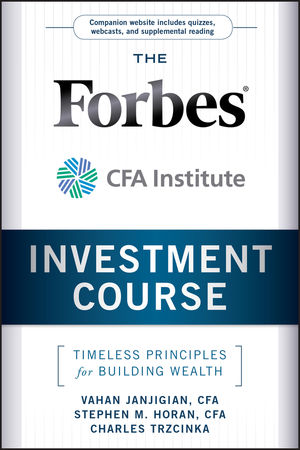The Forbes / CFA Institute Investment Course: Timeless Principles for Building WealthISBN: 978-0-470-91965-1
Hardcover
288 pages
February 2011
 This is a Print-on-Demand title. It will be printed specifically to fill your order. Please allow an additional 15-20 days delivery time. The book is not returnable.
|
||||||
Acknowledgments xvii
Chapter 1 Building Capital 1
Role of the Stock Market in Building Wealth 2
Determining Your Financial Position 3
Your Financial Inventory Guide 4
Investment Margin 11
Defi ning Your Goals 12
Return Requirements 13
Risk Profi le 14
Life Cycle and the Risk/Return Mix 15
Other Considerations 16
Asset Classes 17
Asset Allocation 20
Active versus Passive Investing 22
Diversifi cation 23
Dollar Cost Averaging 24
Chapter Takeaways 31
Chapter 2 How Securities Markets Function 33
Role of Securities Markets 33
The Securities Exchanges 36
Over-the-Counter Markets 37
NASDAQ 38
Electronic Communication Networks 39
Stock Quotes 39
The Third Market 40
Other Markets 40
How the New York Stock Exchange Operates 41
How the NASDAQ Operates 43
From SOES to SuperMontage 44
OTC Bulletin Board and Pink Sheets 45
How the ECNs Operate 45
Crossing Systems 46
Electronic versus Floor Trading 46
Preferencing 48
Internalization 49
Chapter Takeaways 49
Chapter 3 Selecting a Broker and Trading 51
Structure of a Brokerage Firm 52
Activities of a Brokerage Firm 53
Services Offered by All Brokers 54
Full-Service versus Discount Brokers 55
Online Brokers 58
Choosing a Brokerage Firm 58
Commissions 60
Direct Purchase of Securities 62
Placing Orders 63
Odd-Lot Trading 66
Margin 67
Transaction Example 68
Settlement 69
Stock Symbols and the Ticker Tape 70
Questions to Ask Your Broker 71
Chapter Takeaways 73
Chapter 4 Tax-Favored Investment Strategies 75
Capital Gains and Dividends 75
Traditional IRAs 77
Roth IRAs 79
401(k) Plans 80
Education Savings Accounts and 529 Plans 82
Other Pension Plans 83
Mutual Funds and Taxes 85
Using Tax-Advantaged Accounts 86
Chapter Takeaways 87
Chapter 5 Reading Financial Statements 89
Income Statements 91
Balance Sheet 95
Statement of Cash Flows 99
Making Sense of the Numbers 102
Profi tability Ratios 102
Asset Utilization Ratios 105
Leverage Ratios 108
Revisiting ROE 110
Liquidity Ratios 110
Market Multiples 112
Look Beyond the Numbers 114
Read the Footnotes 115
Can You Trust Financial Statements? 115
Chapter Takeaways 119
Chapter 6 Sources for Investment Information 121
Where to Obtain Information 123
Securities and Exchange Commission 124
Earnings Releases and Regulation Fair Disclosure 125
Investment Brokers and Dealers 127
Can You Trust Brokerage House Reports? 128
Investment Newsletters and Other Publications 129
Corporate Reports 130
Reading the Annual Report 130
Government Reports 131
Chapter Takeaways 131
Chapter 7 Common Stocks and Economic Indicators 133
Another Look at the Balance Sheet 133
Why Common Shares Have Value 136
Macroeconomic Factors 136
Industry-Specifi c Factors 140
Other Barometers 141
Evaluating Data 141
Chapter Takeaways 143
Chapter 8 Fundamental Analysis 145
Investing versus Trading 145
Passive Investing 146
Active Investing 147
Business Focus 153
Industry Outlook 154
Company Status 155
Major Trends 157
Earnings History and Outlook 158
Dividends 159
Price-Earnings and Price-Book Ratios Revisited 161
Discounted Cash Flow 163
Evaluating Management 164
Some Final Thoughts on Fundamental Analysis 165
Chapter Takeaways 165
Chapter 9 Technical Analysis 167
The Value of Charts 169
Reading Charts 171
Dow Theory 171
Head and Shoulders 175
Support and Resistance Levels 176
Trading Ranges 177
Breakaway Gaps 178
Importance of Volume 179
Other Technical Indicators 182
Time to Grow Bullish 184
Chapter Takeaways 187
Chapter 10 Fixed-Income Securities 189
Bonds 189
Understanding Bonds 190
Understanding Bond Prices 191
Bond Prices and Interest Rates 192
Call Feature 194
Credit Quality of Bonds 194
Other Issues Concerning Bonds 196
How to Buy Bonds 199
Money Market Securities 200
Preferred Stock 201
Understanding Preferred Stock 202
Tax Treatment 203
Trust Preferred Securities 204
Final Thoughts on Bonds and Preferred Stocks 204
Chapter Takeaways 205
Chapter 11 Derivatives 207
Defi ning Derivative Instruments 207
Futures 209
Spot Asset 209
The Futures Market 210
Delivery 211
Hedging 212
Stock Index Futures 212
Single-Stock Futures 214
Options 215
Defi nition of Options 216
Options Markets 216
Important Terms to Know 216
Listed Options 217
What an Option Is Worth 219
Commissions 221
To Sell or to Exercise 222
Some Popular Option Strategies 222
A Warning about Naked Option Writing 225
Chapter Takeaways 226
Chapter 12 Mutual Funds 229
An Investment Company 229
Closed-End or Open-End 230
A Short History of the Mutual Fund Industry 232
Categories of Mutual Funds 232
Advantages of Mutual Funds 237
Disadvantages of Mutual Funds 238
Mutual Fund Expenses 239
How to Choose a Fund 242
Some Final Thoughts about Mutual Funds 243
Hedge Funds 243
Chapter Takeaways 247
Chapter 13 Rules of Thumb and Key Phrases 249
Final Comments 254
Suggested Readings 255
About the Authors 257
Index 259



